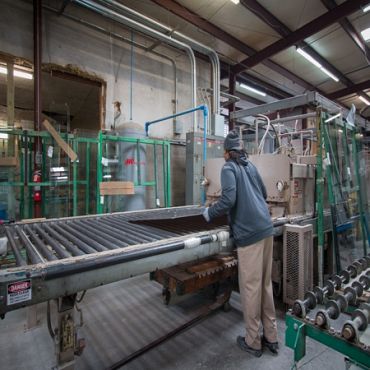The process of glass fabrication involves the transformation of raw glass materials into finished products through various techniques and methods. This process encompasses cutting, shaping, and finishing glass to produce a diverse range of products, including windows, doors, mirrors, and glassware. With a history dating back to ancient Mesopotamia and Egypt, glass fabrication has been an integral part of human civilization for centuries.
Over time, the process has undergone significant evolution, incorporating new technologies and innovations to meet the demands of modern society. Today, glass fabrication plays a vital role in various industries, including construction, automotive, and consumer goods. The glass fabrication process commences with the selection of raw materials, typically consisting of silica sand, soda ash, and limestone.
These materials are melted together at high temperatures to form molten glass, which is then shaped and cooled to create the desired product. The process demands precision and expertise to ensure the quality and integrity of the finished product. From cutting and grinding to polishing and tempering, each step in the glass fabrication process requires meticulous attention to detail and adherence to stringent quality standards.
As technology continues to advance, new techniques and methods are being developed to improve efficiency and enhance the quality of glass fabrication.
1. The Process of Glass Fabrication
i. Raw Material Selection and Preparation
The journey of creating high-quality glass products begins with the selection and preparation of raw materials. Silica sand, soda ash, and limestone are carefully measured and mixed together before being heated to high temperatures in a furnace.
ii. Melting and Forming
This process, known as melting, transforms the raw materials into molten glass, which can then be shaped and formed into the desired product. Once the molten glass has been formed, it is cooled and solidified before undergoing further processing.
iii. Shaping, Treating and Quality Control
After the glass has been cooled and solidified, it is cut and shaped using various techniques such as cutting, grinding, and polishing. These processes require precision and skill to ensure that the glass is cut to the correct size and shape. Once the glass has been cut and shaped, it may undergo additional treatments such as glass tempering or laminating to improve its strength and durability. Quality control measures are implemented throughout the entire process to ensure that the finished product meets the required standards for strength, clarity, and appearance. The process of glass fabrication requires a combination of artistry and technology to create products that are both functional and aesthetically pleasing.
2. Different Techniques and Methods Used in Glass Fabrication
Glass fabrication encompasses a wide range of techniques and methods that are used to create a diverse array of glass products. One of the most common techniques used in glass fabrication is cutting, which involves using specialized tools to cut glass into specific shapes and sizes. This process requires precision and skill to ensure that the glass is cut accurately without causing any damage or imperfections.
Another important technique in glass fabrication is grinding, which is used to smooth the edges of the glass and create a uniform surface. Grinding is often followed by polishing, which further enhances the clarity and appearance of the glass. In addition to cutting, grinding, and polishing, glass fabrication may also involve processes such as tempering and laminating.
Tempering is a heat treatment process that strengthens the glass by creating internal stresses within the material. This makes the glass more resistant to breakage and thermal stress, making it ideal for use in applications where safety is a concern. Laminating involves bonding multiple layers of glass together using a special adhesive, creating a composite material that offers enhanced strength and durability.
3. Quality Control and Safety Measures in Glass Fabrication
Quality control is an essential aspect of glass fabrication, ensuring that the finished products meet the required standards for strength, clarity, and appearance. Throughout the entire process, from raw material selection to final inspection, strict quality control measures are implemented to identify any defects or imperfections in the glass. This may involve using specialized equipment such as optical scanners or automated inspection systems to detect flaws that are not visible to the naked eye.
In addition to quality control measures, safety is also a top priority in glass fabrication. The process involves working with high temperatures and sharp tools, making it essential to follow strict safety protocols to prevent accidents and injuries. To ensure the safety of workers and the quality of the finished products, glass fabrication facilities must adhere to strict safety regulations and standards.
This may include providing workers with personal protective equipment such as gloves, goggles, and heat-resistant clothing, as well as implementing safety training programs to educate employees on best practices for working with glass. Quality control measures may also involve conducting regular inspections of equipment and facilities to identify any potential hazards or areas for improvement. By prioritizing quality control and safety measures, glass fabrication facilities can ensure that their products meet the highest standards for quality and safety.
4. Applications and Future Trends in Glass Fabrication
Glass fabrication plays a crucial role in a wide range of industries, with applications ranging from construction and automotive to consumer goods and electronics. In the construction industry, glass fabrication is used to create windows, doors, and facades that provide natural light and aesthetic appeal to buildings. In the automotive industry, glass fabrication is used to create windshields, windows, and mirrors that enhance safety and visibility for drivers.
Glass fabrication also plays a key role in consumer goods such as glassware, cookware, and decorative items that are used in homes and businesses. Looking ahead, future trends in glass fabrication are likely to focus on sustainability and innovation. As environmental concerns continue to grow, there is increasing interest in developing sustainable materials and processes for glass fabrication.
This may involve using recycled materials or implementing energy-efficient technologies to reduce the environmental impact of glass production. In addition to sustainability, innovation will also play a key role in shaping the future of glass fabrication. Advancements in materials science and technology are likely to lead to new techniques and methods for creating high-performance glass products with enhanced strength, durability, and functionality.
Explore Custom Glass Fabrication Services in Nashville TN
In conclusion, glass fabrication is a multifaceted industry that plays a crucial role in various sectors, from construction and architecture to automotive and interior design. The processes involved in glass fabrication, such as cutting, shaping, and tempering, are essential for creating durable and aesthetically pleasing products that meet the diverse needs of consumers and businesses alike. As technology continues to advance, the capabilities of glass fabrication are expanding, allowing for innovative designs and applications that were once thought impossible.
For those seeking reliable and high-quality glass fabrication services in Nashville TN, Evans Glass Company stands out as a leader in the field. With a commitment to excellence and customer satisfaction, Evans Glass Company is well-equipped to handle your glass tempering order needs efficiently and effectively. Our expertise ensures that you receive products that not only meet industry standards but also align with your specific requirements.
Our dedication to quality craftsmanship and quick turnaround times positions us as a trusted resource in the glass fabrication industry.






